Roy Wilkinson on where DIY book publishing meets Nazi Gold, amazing rock music and the Siberian jay.
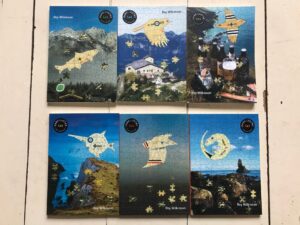
If you’re only going to buy one record this year, then don’t buy two… Similarly, perhaps, if you’re going to put out a book, then maybe don’t put out six.
In 2011 I put out just the one book, my first book – Do It For Your Mum, a fretboards/family/forestry memoir based around my time as manager of the rock group British Sea Power (now just Sea Power). My two youngest brothers are the group’s singers, while our then 80-year-old dad developed an amazing, kamikaze level of devotion for the band. Caught by the River made Do It For Your Mum their (joint) book of the year. Then CBTR ran an article in which I looked at DIY publishing, giving a breakdown of the costs and income for Do It For Your Mum. I was thinking of early Scritti Politti singles where, on the sleeve, they’d sometimes include the costs of making the record. Here I’m returning to this kind of project analysis, giving costs and income for my new book. This book is called Dark Lustre and it comes in six volumes. Why six volumes? We’ll come to that. First let’s have the projected costs and potential profit for these books – books that would be produced to a free-range DIY agenda.
COSTS
Research: £1,927
Printing six volumes: £5,160
Post and packaging (the vast majority of books would be sold by mail order): £5,922
Proofreading and editing: £700
Graphics / art work: £500
TOTAL: £14,209
PROJECTED INCOME
£25,773
POTENTIAL PROFIT
£11,564
The Dark Lustre books have indeed made a profit. But, before we get into that, here’s a little on the content of the books.
I avoid calling Dark Lustre a novel, preferring “non-non-fiction”. It’s a hybrid form – a kind of fiction but studded with non-fiction elements. There are two main characters. Tommy Quantox is a retired Royal Navy technician from North Devon. Pamela Budeaux is the singer/guitarist in an amazing rock trio called The Countess Marie-José de la Barre d’Erquelinnes Hextet – generally known as the Hextet. Amazingly enough, the following film footage seems to say the Hextet also now exist outside the Dark Lustre books, in the real world.
The Dark Lustre story is set in our contemporary era, starting with a dead body on the North Devon shore. The narrative moves to Bavaria and Berlin, where we find a terrible past infusing the present. The writer Cathi Unsworth picked up on Dark Lustre’s dark historicity when she commented on the books: ‘A compelling adventure, leading from eerie North Devon cliffs to a haunted, history-riven Germany.’ The prose in Dark Lustre is intended as lucid – direct enough to take the reader through numerous digressions. There are many detours. On what an Anglo-Saxon horseman might make of a discarded energy-drink can, on Emperor Haile Selassie and on a book called Collectible Spoons Of The Third Reich. There are digressions on Tempelhof airfield, on delusional Nazi gold, on Fucking Festival at the village of Fucking in Austria and on “lying’s free-jazz stage”. And let’s not forget the Unglückshäher – a bird with an ominous German name, the “bad luck jay”. In English, the Siberian jay.
There were two research trips to Germany for the books. I went to Berlin’s Olympiastadion, home of the 1936 “Hitler Olympics”. I visited Berchtesgaden in Bavaria, heading up the site of the Berghof – Hitler’s wartime Alpine HQ, sat just below the mountain-top Eagle’s Nest. The latter is still there, now a café with spectacular views. The Berghof was destroyed – by the RAF and then, in 1952, by the Bavarian state government. I took a bus a few miles out of town, to the paradise of the lake Königssee. In different times Eva Braun did gymnastics on the shore. Today you can take a trip on a pleasure boat. They stop half way down the lake, where one of the crew opens a door and plays a trumpet. It’s magical, haunting, to hear Edelweiss echo back, crystal clear from the mountains.
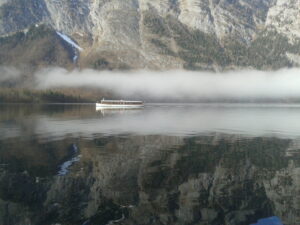
My research took me to Munich and to “Krautrock Düsseldorf”. In the latter city, I visited the site of the key kosmische Musik club, Creamcheese. At night I walked over the big Oberkasseler Brücke road bridge, looking back spellbound at Kraftwerk’s “Stadt aus Licht”, their city made of light. In the morning I found the original site of Kraftwerk’s Kling Klang studio. It wasn’t hard to locate. The current owner had a traffic cone outside, symbolic tribute to the group. Much of what I saw in Germany made it into Dark Lustre, sometimes fictionalised, sometimes not.
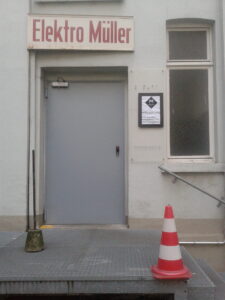
DARK LUSTRE COSTS
I’ve published Dark Lustre as a limited edition of 667 six-book sets – one more than the mere number of the beast. My budget was based on a printing cost of £860 for 750 books for each instalment. The print runs were of 750 because an order can come in at up to five per cent above or below the number requested. My marketing plan consisted almost entirely of sending the books to writers and musicians I knew. I would need quite a few books for this.
I had a core potential audience in mind for Dark Lustre. Naturally, many of the people who’d bought my Do It For Your Mum book were keen on Sea Power. Though I’d stopped managing the band in 2006, I was able to employ the Sea Power mailing list, to tell people about Dark Lustre. Within a month of the books going on sale I had 250 Dark Lustre subscribers. In the UK I could send the books as “large letters” at £1.40 per book. With a tasty, recyclable, card mailer, P&P came in at £1.48 a book.
Total projected printing cost:
6 x 750 books = 6 x £860 = £5,160.
If I sold all the books to people in the UK total P&P would be:
667 x 6 x £1.48 = £5922.
I created the Dark Lustre cover art myself – photos I’d taken, then turned into 500-piece jigsaws and then augmented with gold foil, model-kit decals and Humbrol enamel paints. Manufacture of the six jigsaws cost around £30 each. All of the books’ 12 chapters came with a little header graphic. These were mainly done by Matthew Wood, then drummer with Sea Power. Woody was paid for these but he charged on a friendly basis.
DARK LUSTRE INCOME
I sold the books at £40 a set in the UK, including P&P. Income from each UK sale was £40 minus PayPal fees of £1.46, so £38.64 income per set.
If all 667 sets of Dark Lustre were sold in the UK then income would be £25,773.
But why six volumes? I’d calculated that doing the book in six instalments should mean more profit than just having one book and selling it for, say, £20. But there were other things I liked about the Dark Lustre print sextet. A playful kind of numerology became apparent. If I sold the books for £40 a set then 40 ÷ 6 = 6.666667. Surely, all these sixes were auspicious with books majoring on a band known as the Hextet? (I initially thought “hextet” meant a thing with six aspects. I later found it’s something slightly different – one definition is to do with computingand a “6-bit aggregation”…)
Having six books would also do wonders for the author’s oeuvre. I suddenly went from a writer of one book to a writer of seven books. Also, one of the supporting characters in Dark Lustre makes partworks – the peculiar publishing form where you get weekly instalments from your newsagent and then build a life-size plastic human skeleton or a scale-model Nazi submarine. Partworks are a kind of leitmotif in Dark Lustre.
I chose to self-publish Dark Lustre mainly because I thought that if I took this idea to the publishing industry it would be seen as novel. I didn’t see it as a novel. My education in languages stopped at O-level. I didn’t see myself as part of any literary world – and I thought that was a good thing. Advances for debut novels are often pretty low. I reckoned I’d make more doing it myself. In publishing the books on my own I also thought, in some ways, I’d be “following the path of most resistance”. I’m not sure why but this seemed like a good idea.
I was trying to operate outside the publishing industry, but to say I was working unaided would be a lie. Mathew Clayton, an editor at Unbound Books, kindly advised me on several aspects of Dark Lustre. Kevin Bartholomew, a journalist and editor I knew through Sea Power, meticulously edited and proofread the books. Kevin was paid for this – but at a rate, given the time taken, far below the UK minimum wage. Dark Lustre has a small but significant amount of text in German, generally explained through elliptical translation. Because of this I also had a German editor, Denise ‘Denni’ Breyer. Again, I’d met Denni through Sea Power. She’s from Blackpool, but on marrying German national Mikey Breyer – formerly drummer with the art-rock group Art Brut – Denni had started a new life in Bavaria, where she’d become fluent in German.
Typesetting and design on the books was overseen by my friend Wilf Dickie, who I’ve known since we were both 13. In the late ’70s, on my first day at a new school on the edge of the Lake District, I turned up with the crest design from Queen’s A Night At The Opera album inked on my ex-army rucksack. Looking round at my new classmates I noticed Wilf had the crest from Queen’s A Day At The Races album on his ex-army rucksack. In my mind, that day a friendship was born, one that endures to this day. Wilf has worked in publishing for decades, as a book designer and expert typesetter. Lucky for me. There’s a lot of ‘display text’ in Dark Lustre – text that required special treatment, as below. Thankfully, Wilf didn’t charge for his work.
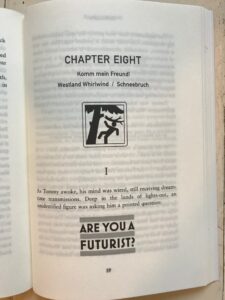
BUT! On costs and income there were additional complexities. Postage costs were more involved than I’ve indicated above. For years I’ve bought old decimal UK commemorative stamps from a stamp dealer – the ‘picture stamps’ the Royal Mail puts out every year to celebrate Dr Who and Christmas and so on. I get these stamps at 65 per cent of face value. This helps with post costs and also means I can send Dark Lustre magically adorned. For decades UK commemorative stamps have been wonderful, affordable public works of art. You can stick them on a letter to a pal or, in a subtle act of subversion, lick one of the 1999 Freddie Mercury stamp and affix it to a Tory anti-immigration poster. That’ll learn the fuckers.
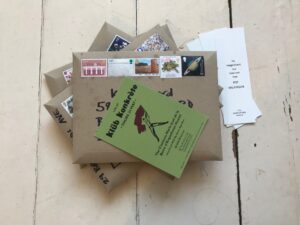
My postage method was labour intensive, but I liked sticking on the stamps – and then taking the books to a post box so they could head out to Winterport Cluster in Virginia, to Wohlers Allee in Hamburg, to the Isle of Mull, to Singapore, to Mr George F. Killgoar III in Massachusetts.
Other things increased Dark Lustre costs, including time… When I started posting out DL volume 1 in November 2020, I had 70,000 words written of what would become a 120,000-word narrative. I was hoping I’d work fast enough to send out the remaining five volumes in the next six months. But I was my own boss, acting as production editor and project manager. No one to answer to on deadlines. I found myself revising what I’d written. There were also weeks of debilitating self-doubt. Time crept on. In the end, it wasn’t until June 2023 that the final DL volume came back from the printer.
In February 2022 Russia invaded Ukraine. A lot of UK wood pulp came from Russia or the Baltic. The Russian pulp was no longer available. Rising fuel prices increased the cost of transport. With Dark Lustre volume five, the print cost rose from £860 to £1,304. Because I’d taken so long to finish the books I was also hit by increased Royal Mail charges. The cost of UK delivery of each DL book rose from £1.40 to £2.40. A book to Australasia went from £5.62 to £7.50.These extra costs were my own fault. I didn’t even think about asking subscribers to pay for extra costs. Also, some DL sets were sold at reduced prices to people with low incomes.
I now realise that even if I tried my best to compute all costs and all income, total accuracy could not be guaranteed. It feels best that, rather than aim for forensic accuracy, I “take a view” on costs and income…
My estimate is that, when all 667 DL sets are sold, I’ll be looking at profit of around £11k. This is more than the advance you’d often get for a first-time novel. Yet the time I’ve expended means income has been at a rate clearly below the UK minimum wage. But shed no tears. I did it for art. My domestic financial gearings are modest and manageable.
With Dark Lustre I once again employed that ancient technology, writing – using this amazing physical and neuropsychological system to send the interior thoughts of one mind to another. From here in South Devon, across North Devon, across Bavaria and Berlin. Putting that writing in a package and sending it to Sweden and Canada and Portugal and Dubai. All across the world, to the Isle of Mull and to Winterport Cluster in Virginia.
Was it worth it? I’m proud of these books and the reaction they’ve had. One day I was in the Lake District, by the shore at Coniston. An email arrived with thoughts from New Order’s Stephen Morris: “I’m really enjoying Roy Wilkinson’s Dark Lustre series. If tales of mysterious death, Nazi treasure in Devon, the world’s first Black Leather Bubble Car and an unspeakably brilliant all-girl band sound like your cup of literary tea, look no further.” I think of New Order as “the band of my life”. I was overwhelmed by this reaction. There was other encouraging feedback. Benjamin Myers, author of novels including Cuddy and The Gallows Pole, said: “Roy Wilkinson’s lustre for life is intoxicating, while his ability to find stories in every hidden crevice of both past and present is a real rarity.” Broadcaster and writer Stuart Maconie said: “A kaleidoscope of ideas, characters, jokes, theories and terrific writing.”
I like the way I did follow a path of most resistance with Dark Lustre. But I can’t imagine ever again writing a book where I’m in charge, where I don’t have someone else enforcing deadlines.
As I write there are 87 sets of Dark Lustre still for sale. Yule time is coming and I’m hoping soon all the 667 Dark Lustre sextets will be out there. As with a Christmas tree, the books feature glistening gold. The books are also, I contend, a solid gold investment. My book Do It For Your Mum doesn’t often come up for sale and when it does it goes for a chunk of cash. Do It For Your Mum was an edition of 2,011. Dark Lustre is an edition of 667. You do the maths…
You can try Dark Lustre before you buy. There’s a nice downloadable PDF of DL1 at the bottom of the page here.
Or you can just go here and subscribe – Dark Lustre in the post, every month for the next six months. No delays, guaranteed.